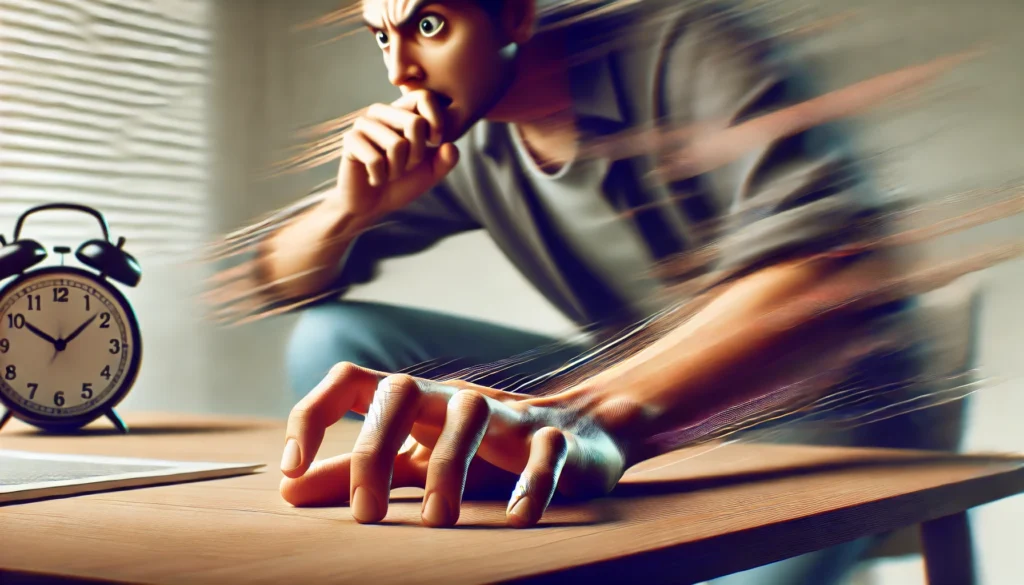The intricate connection between body and mind is a fascinating subject that has captivated scientists, therapists, and wellness enthusiasts alike. In the realm of mental health, particularly anxiety and stress, the physical manifestations of emotions often speak louder than words. This article delves into the world of anxious poses, exploring how body language can offer insights into our mental states and how practices like yoga can serve as a powerful tool for managing anxiety.
You may also like: Natural Supplements for Effective Anxiety Relief

The Science Behind Anxious Poses
Body language is a rich tapestry of nonverbal cues that reveal our innermost feelings and thoughts. Anxious poses, characterized by hunched shoulders, crossed arms, and fidgeting, are physical manifestations of anxiety and stress. Understanding these cues can provide valuable insights into mental health and offer avenues for intervention.
What Are Anxious Poses?
Anxious poses are specific body language signals that indicate discomfort, nervousness, or fear. These may include:
- Tension in the Shoulders and Neck: Often, stress and anxiety manifest as physical tension, particularly in the shoulders and neck. This is a protective response, as the body instinctively prepares to defend itself against perceived threats. When the shoulders and neck are tense, it can lead to chronic pain and discomfort, further exacerbating anxiety levels. Massage and relaxation techniques can help alleviate this tension, promoting a sense of calm.
- Crossed Arms and Legs: These poses can indicate a desire for protection or self-soothing, often seen in individuals who are experiencing anxiety or stress. Crossed arms can also signal defensiveness or a lack of openness, which might affect interpersonal relationships. Being aware of these postures can help individuals consciously choose more open and relaxed poses, fostering better communication and connection with others.
- Fidgeting and Restless Movements: Constant movement, such as tapping fingers or bouncing legs, is a common sign of anxiety, reflecting an internal state of unrest. These movements serve as an outlet for nervous energy and can be a distraction in social or professional settings. Identifying triggers for fidgeting and employing calming techniques, like deep breathing, can reduce these restless behaviors.
The Psychological Implications
Anxious poses do not only reveal current emotional states but can also perpetuate feelings of anxiety. Research indicates that the way we hold our bodies can influence our emotions. For instance, maintaining an open, expansive pose can enhance feelings of confidence and reduce stress, while closed, constricted postures can exacerbate anxiety.
- Impact on Self-Perception: The way we physically present ourselves can influence how we perceive our own capabilities and worth. Adopting expansive poses can lead to a more positive self-image and increased self-assurance, creating a feedback loop of confidence and reduced anxiety. Conversely, anxious poses can reinforce negative self-talk and feelings of inadequacy.
- Social and Professional Consequences: Body language significantly affects how we are perceived by others. Anxious poses may lead to misunderstandings, as they can be interpreted as disinterest or unfriendliness. By cultivating awareness of body language, individuals can enhance their social interactions, building more positive and effective relationships.
- Physiological Effects: The link between posture and physiology is profound, with certain poses affecting hormonal balance. For instance, adopting a power pose can increase testosterone and decrease cortisol, the stress hormone, leading to reduced anxiety and improved mood. Understanding these physiological mechanisms highlights the importance of body language in emotional regulation.
Yoga: A Pathway to Calm
The practice of yoga is an ancient discipline that has gained modern acclaim for its ability to harmonize the mind and body. For those grappling with anxiety and stress, yoga offers a sanctuary of calm and a means to alter anxious poses into empowering ones.
How Does Yoga Help with Anxiety?
Yoga’s effectiveness in managing anxiety and stress lies in its holistic approach, which incorporates physical postures (asanas), breathing exercises (pranayama), and meditation. Here’s how it works:
- Physical Postures: Yoga poses help release tension from the body, promoting relaxation and reducing physical manifestations of anxiety. Asanas such as Child’s Pose, Corpse Pose, and Legs-Up-the-Wall Pose are particularly effective in calming the nervous system. The physical act of stretching and holding poses increases body awareness, which helps individuals recognize and release stored tension.
- Breathing Exercises: Pranayama, or controlled breathing, is a cornerstone of yoga that helps regulate the autonomic nervous system. Techniques like deep belly breathing and alternate nostril breathing can reduce stress and induce a state of relaxation. These breathing exercises increase oxygen flow to the brain, promoting clarity and focus, which are essential in managing anxiety.
- Meditation and Mindfulness: These practices cultivate an awareness of the present moment, reducing rumination and anxiety about the future or past events. Mindfulness encourages individuals to observe their thoughts and emotions without judgment, fostering acceptance and reducing the power of anxiety triggers. Regular meditation practice can rewire neural pathways, promoting a more resilient mental state.
Best Yoga Poses for Stress and Anxiety
- Child’s Pose (Balasana): This gentle, restorative pose helps release tension in the back, shoulders, and neck, promoting a sense of security and calm. By folding forward, individuals can experience a grounding effect, which is soothing for the nervous system.
- Corpse Pose (Savasana): Often practiced at the end of a yoga session, Savasana allows the body to integrate the benefits of the practice, promoting deep relaxation. This pose encourages complete surrender, helping to reset the body’s stress response and cultivate inner peace.
- Legs-Up-the-Wall Pose (Viparita Karani): This inversion pose encourages blood flow to the brain, aiding in relaxation and reducing anxiety symptoms. The gentle inversion supports lymphatic drainage and circulation, contributing to overall well-being.

Historical Context and Current Trends
Yoga’s journey from ancient India to modern wellness studios worldwide is a testament to its enduring appeal and efficacy. Historically, yoga was practiced as a spiritual discipline, with a strong emphasis on meditation and breath control. Today, it has evolved into a popular form of exercise and stress relief, particularly in the West.
The Rise of Yoga for Mental Health
In recent years, the integration of yoga into mental health treatment plans has gained momentum. Therapists and wellness coaches recognize yoga as a complementary therapy that can enhance traditional treatment approaches for anxiety and depression.
- Integration into Therapy: Many therapists incorporate yoga principles into cognitive-behavioral therapy and other modalities to address anxiety. By combining movement with traditional talk therapy, clients can experience a more holistic approach to healing.
- Community and Support: Yoga classes create a sense of community, offering individuals a supportive environment to explore their mental health challenges. Group practices can foster a shared sense of purpose and connection, reducing feelings of isolation.
- Research and Validation: Ongoing studies continue to validate yoga’s effectiveness in reducing symptoms of anxiety and depression. This growing body of evidence supports its inclusion as a viable option in mental health care.
Future Implications
As research into the benefits of yoga continues, its role in mental health care is likely to expand. Innovations in biofeedback and wearable technology may further enhance the practice, offering personalized insights into the physiological effects of yoga on the body and mind.
- Technological Integration: Wearable devices that monitor heart rate and stress levels can be used alongside yoga practices to provide real-time feedback and personalized adjustments. This technology can help practitioners tailor their yoga sessions to maximize stress reduction and emotional balance.
- Global Accessibility: Online platforms and virtual yoga classes have made the practice accessible to a global audience. This increased accessibility allows individuals from diverse backgrounds to experience the benefits of yoga for mental health.
- Interdisciplinary Approaches: As yoga becomes more integrated into mainstream healthcare, there is potential for interdisciplinary collaboration between yoga instructors, therapists, and healthcare providers. Such collaboration can lead to more comprehensive and individualized care plans for those with anxiety.
Practical Advice for Incorporating Yoga into Daily Life
For individuals seeking to manage anxiety and stress through yoga, consistency is key. Here are some practical tips to help integrate yoga into daily routines:
- Start Small: Begin with short, manageable sessions and gradually increase the duration as you become more comfortable with the practice. Consistency in practice, even if brief, is more beneficial than sporadic longer sessions.
- Create a Dedicated Space: Establish a quiet, clutter-free area in your home for yoga practice to enhance focus and relaxation. Personalize this space with calming elements such as candles, plants, or soothing music to create an inviting atmosphere.
- Seek Guidance: Consider attending yoga classes or working with a certified instructor to ensure proper alignment and technique. Professional guidance can prevent injury and deepen your understanding of the practice, enhancing its benefits.
- Be Patient: Remember that yoga is a journey, not a destination. Allow yourself time to explore different poses and breathing techniques to find what works best for you. Embrace the learning process and be open to adapting your practice as your needs and abilities evolve.

Conclusion
Understanding anxious poses and their implications is a valuable tool in the pursuit of mental health and well-being. By incorporating yoga into daily life, individuals can transform these poses into powerful expressions of calm and strength, paving the way for a more balanced and peaceful existence. As we continue to explore the intricate connection between body language and mental health, practices like yoga offer a promising path toward anxiety relief and overall wellness.
Embrace the journey of yoga, and let each pose guide you toward a state of tranquility and empowerment. With time, patience, and dedication, yoga can become a cornerstone of your mental health regimen, offering profound insights and healing for the mind and body.
Further Reading:
Restorative Yoga Poses for Anxiety
Yoga for Anxiety: 11 Poses to Try
7 Easy Yoga Poses for Depression and Anxiety
Important Note: The information contained in this article is for general informational purposes only, and should not be construed as health or medical advice, nor is it intended to diagnose, prevent, treat, or cure any disease or health condition. Before embarking on any diet, fitness regimen, or program of nutritional supplementation, it is advisable to consult your healthcare professional in order to determine its safety and probable efficacy in terms of your individual state of health.
Regarding Nutritional Supplements Or Other Non-Prescription Health Products: If any nutritional supplements or other non-prescription health products are mentioned in the foregoing article, any claims or statements made about them have not been evaluated by the U.S. Food and Drug Administration, and such nutritional supplements or other health products are not intended to diagnose, treat, cure, or prevent any disease.


